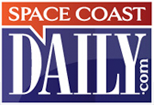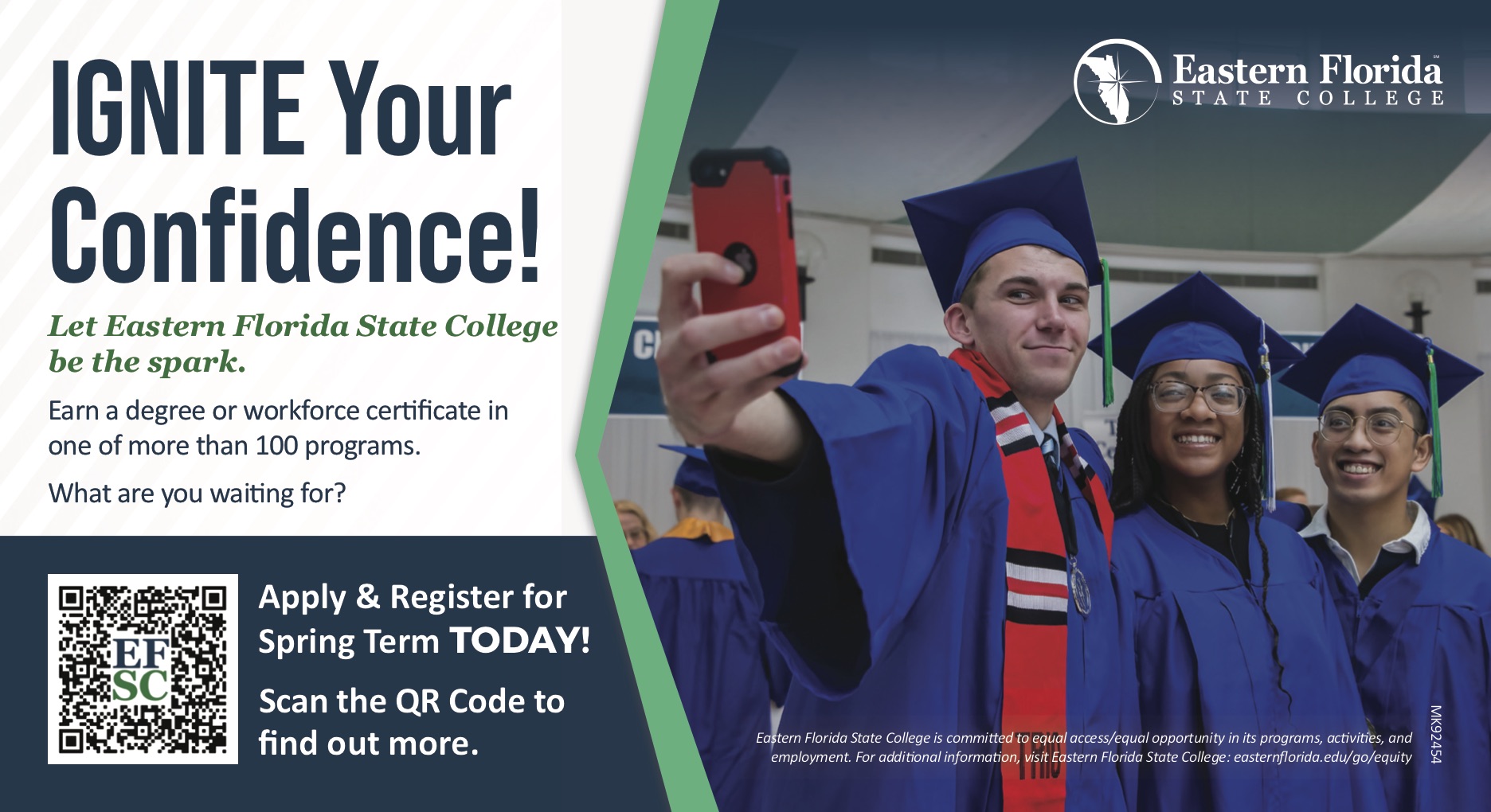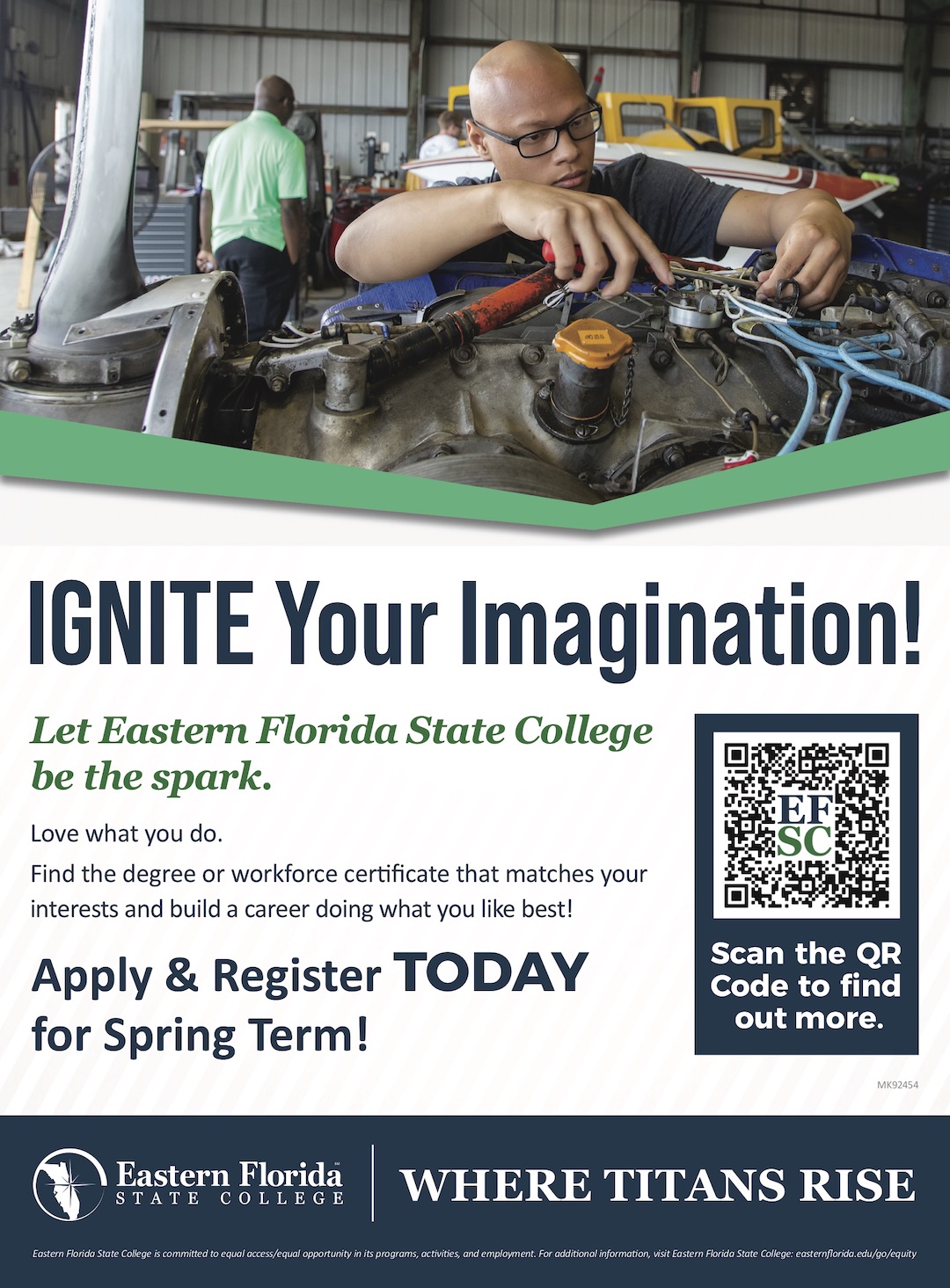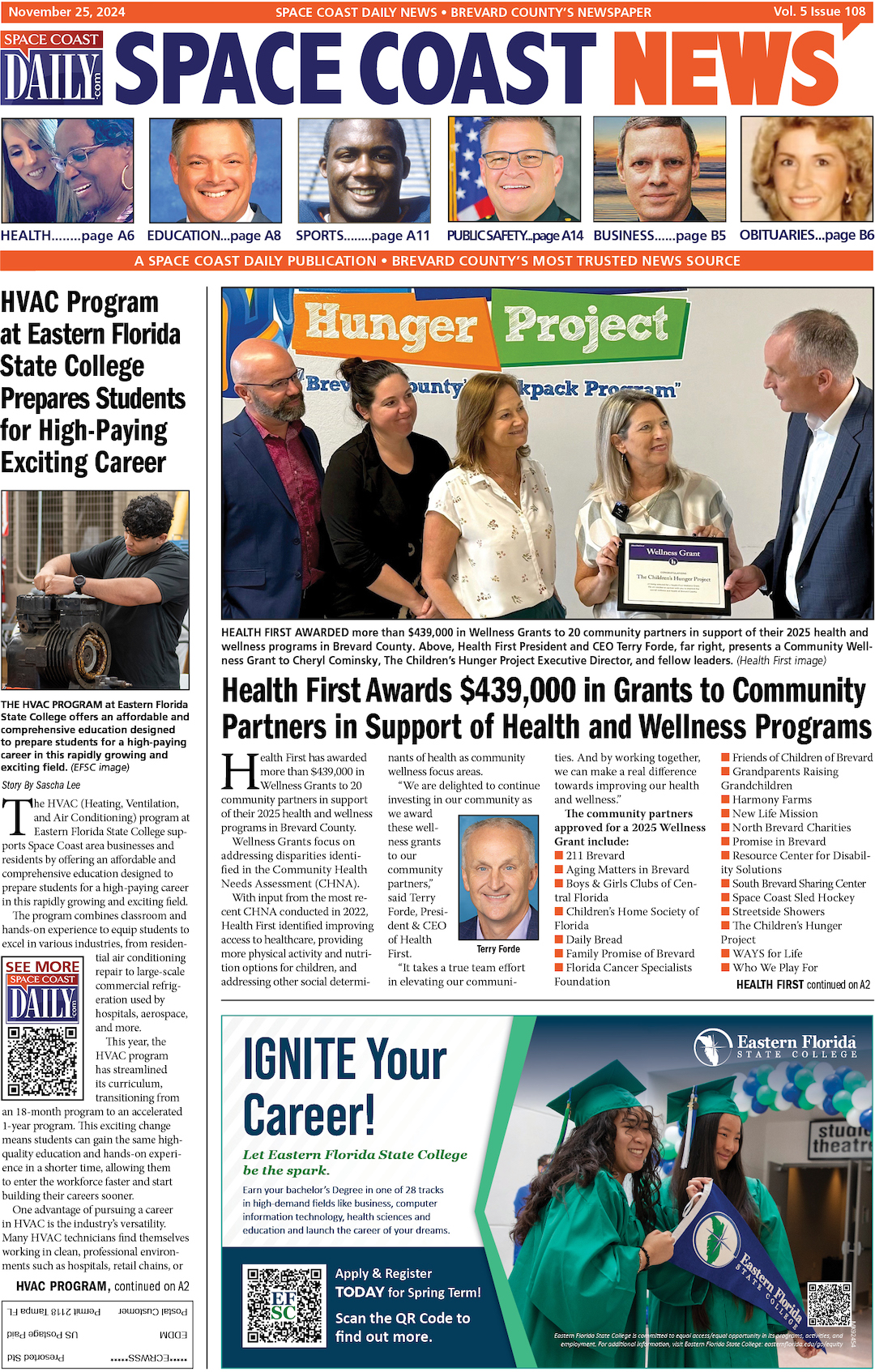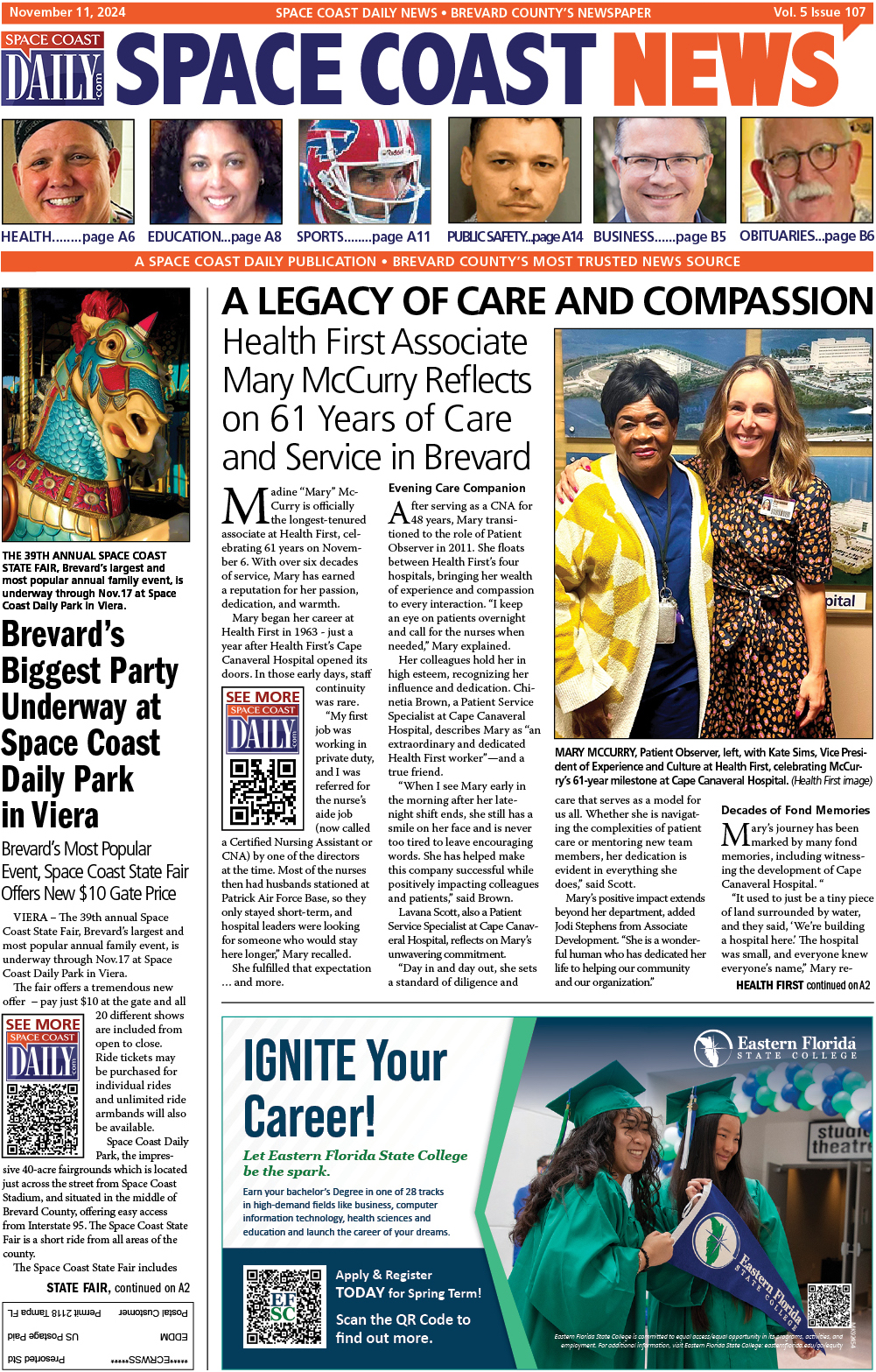OBITUARY: Former NASA Astronaut Thomas Stafford, 93, Passes Away Monday at Home in Satellite Beach
By Space Coast Daily // March 19, 2024
'This nation has lost one of its great heroes'

BREVARD COUNTY SATELLITE BEACH, FLORIDA – Former NASA astronaut Thomas Stafford, who flew to the moon before leading the first international space mission carried out by the United States and Russia, died at the age of 93 on Monday at home in Satellite Beach after an extended illness, according to Max Ary, director of the Stafford Air and Space Museum in Oklahoma.
“This nation has lost one of its great heroes,” said Ary in a call with collectSPACE. “We are so shocked and saddened by his passing. It’s just hard to say because he was bigger than life.”
In 1953, Stafford married Faye Shoemaker from Weatherford, Oklahoma. Faye and Stafford had two daughters, Dionne (born 1954) and Karin (born 1957). Faye and Stafford divorced in 1985. Stafford later married Linda Ann Dishman in December 1988. They had two adopted sons, Michael Thomas and Stanislav “Stas” Patten. Stafford enjoyed hunting, weight lifting, gliding, scuba diving, fishing and swimming.
A member of NASA’s second class of astronauts selected in 1962, Stafford made four flights into space. His contributions to space exploration continued far beyond his career as an astronaut, up until the time of his death.
Stafford commanded a dress rehearsal flight for the 1969 moon landing and the first U.S.-Soviet space linkup, and retired a three-star general.
Before Apollo 10, he flew on two Gemini flights, including the first rendezvous of two U.S. capsules in orbit. He died in a hospital near his Space Coast Florida home, said Max Ary, director of the Stafford Air & Space Museum in Weatherford, Okla. Stafford was one of 24 people who flew to the moon, but he did not land on it.
Only seven of them are still alive.
“Today General Tom Stafford went to the eternal heavens which he so courageously explored as a Gemini and Apollo astronaut as well as a peacemaker in Apollo Soyuz,” NASA Administrator Bill Nelson said via X, formerly known as Twitter. “Those of us privileged to know him are very sad but grateful we knew a giant.”
Stafford was born on September 17, 1930, in Weatherford, Oklahoma to parents Thomas and Mary Stafford. At just five years old, Stafford’s interest in aviation started while watching what looked like a giant silver bird flying over (it was a DC-3 airplane) and he said, ‘I want to do that!’ He made his first flight in a Piper Cub airplane at the age of 14. Tom graduated from Weatherford High School in May 1948, just days before his father passed away from cancer.
Stafford graduated with honors in 1952 from the U.S. Naval Academy, Annapolis, Maryland, and was commissioned a second lieutenant in the United States Air Force. He received his pilot’s wings at Connally AFB, Waco, Texas in September 1953. He completed advanced interceptor training and was assigned to the 54th Flight Interceptor Squadron, Ellsworth AFB, Rapid City, South Dakota.
In December 1955, he was assigned to the 496th Fighter Interceptor Squadron, Hahn Air Base, Germany, where he performed the duties of pilot, flight leader, and flight test maintenance officer, flying F-86Ds.
He attended the USAF Experimental Test Pilot School, and received the A.B. Honts award for outstanding graduate. He became an instructor in flight test training, and specialized academic subjects, establishing basic textbooks and directing the writing of flight test manuals for use by the staff and students. He is co-author of the Pilot’s Handbook for Performance Flight Testing and the Aerodynamics Handbook for Performance Flight Testing.
Stafford was selected among the second group of astronauts in September 1962 by the National Aeronautics and Space Administration (NASA) to participate in Projects Gemini and Apollo. In December 1965, he piloted Gemini VI and performed the first rendezvous in space, and helped develop techniques to prove the basic theory and practicality of space rendezvous. In June 1966, he commanded Gemini IX and performed a demonstration of an early-phase rendezvous that would become standard in later Apollo lunar missions, the first optical rendezvous, and demonstrated a lunar orbit abort rendezvous.
From August 1966 to October 1968, Stafford headed the mission planning analysis and software development responsibilities for the astronaut group for Project Apollo. He was the lead member of the team that helped formulate the sequence of missions leading to the first lunar landing mission. He demonstrated and implemented the theory of a pilot manually flying the giant Saturn V booster into orbit, and the technique for the critical translunar injection maneuver.
In May 1969, Stafford commanded the Apollo 10 mission to the moon, piloting the first Lunar Module (LM) into lunar orbit. The highly successful mission was the final full-scale dress rehearsal for the lunar landing of the Apollo 11 mission just two months later. Stafford flew the LM down to within nine miles of the moon’s surface designating the landing ellipse for the first landing, performed the first lunar rendezvous, conducted reconnaissance on future Apollo landing sites, and proved all the necessary elements of the lunar landing, with the exception of the actual landing itself.
During the Apollo 10 reentry, General Stafford and his crew were recognized by the Guinness Book of World Records for reaching the highest speed ever attained by man, when the spacecraft reached a speed of 24,791 statute miles per hour – Mach 37. This ultimate speed record still holds today, and may not be exceeded until an astronaut crew returns from a mission to Mars.
Following his return from the moon, Stafford was assigned as the Chief of the Astronaut Office in June 1969, and was responsible for the selection of flight crews for Projects Apollo and Skylab. He reviewed and monitored flight crew training status, and was responsible for coordination, scheduling, and control of all activities involving NASA astronauts.
In June 1971, Stafford was named as the Deputy Director of Flight Crew Operations at the NASA Manned Space Flight Center (later known as the Johnson Space Center) in Houston. He was responsible for assisting the center director in planning and implementation of programs for the astronaut group, Aircraft Operations, Flight Crew Integration, Flight Crew Procedures, and Crew Simulation and Training Divisions.
General Stafford became the first general to fly into space when he logged his fourth space flight as Apollo commander of the Apollo-Soyuz Test Project (ASTP) mission, July 15-24, 1975. This mission was the first international space flight, and was joint mission culminating in the historic “first handshake in space” between American astronauts and Soviet cosmonauts. Historians now consider the mission as the beginning of the end of the Cold War, and for his efforts, General Stafford was nominated for the Nobel Peace Prize.
General Stafford was promoted to the grade of Major General in August 1975. He left NASA in November 1975 to assume the command of the Air Force Flight Test Center at Edwards AFB, California. As part of his responsibilities, he also assumed the operational command of the Groom Lake Test Facility (better known as “Area 51”) in Nevada, the Hill-Dougway-Wendover Test Range in Utah, and the Parachute Test Facility in El Centro, California. During his tenure, he was responsible for the testing oversight of the F-15, YF-16, YF-17 (later to become the F-18), the A-10, B-1A, YC-14, YC-15, C-141B, Air Launch Cruise Missile (ALC), “Have Blue” (the first experimental stealth aircraft), and the safety and operations oversight of the Approach and Landing Test (ALT) Program for the Space Shuttle.
General Stafford was promoted to Lt. General in March 1978, and in May 1978 assumed the duties as the USAF Deputy Chief of Staff for Research, Development and Acquisition, HQ USAF, Washington, D.C. In addition to the standard duties of his position, in 1979, General Stafford personally initiated the development of the F-117A stealth fighter program. Stafford then wrote the initial design specifications for, and started the Advanced Technology Bomber development (ATV) Program (later renamed the B-2A Stealth Bomber) even though no statement-of-need or requirements existed.
He initiated the Advanced Cruise Missile program, designated as the AGM-129 Stealth Cruise Missile, and started the F-110 Afterburning Turbo-Fan Fighter engine program. He also initiated what would become the roadmap for the Advanced Tactical Fighter (ATF), which would become the F-22A Stealth Fighter. General Stafford retired from the Air Force in November 1979.
By the end of his military and NASA career, General Stafford was the first member of his Naval Academy Class of 1952 to pin on the first, second and third stars of a General Officer. He flew six rendezvous in space; logged 507 hours and 43 minutes in space flight time, and wears the Air Force Command Pilot Astronaut Wings. He has flown over 127 different types of aircraft and helicopters, four different types of spacecraft, and rode three different types of boosters into space.
In December 1979, former California Governor Ronald Reagan asked General Stafford to join his 1980 presidential campaign team as his Air Force defense advisor, and was on Reagan’s transition team after his election as President in November 1980.
In June of 1990, Vice-President Dan Quayle and the NASA Administrator asked General Stafford to form and become Chairman of a team to independently advise NASA how to carry out President Bush’s Space Exploration Initiative, his vision of permanently returning to the moon, and then go on to explore Mars.
General Stafford assembled teams of 40 full-time and 150 part-time members from the DOD, DOE, NASA, as well as obtaining inputs from academia, and many industrial groups to conduct the one year comprehensive study. The result was “America at the Threshold,” a road map for the next 30 years of the U.S. Manned Space Flight Program. General Stafford and Vice-President Quayle held a joint press conference at the White House in June 1991 to announce the recommendations to the public.
In 1994, the Clinton Administration directed a review of all federally-funded research and development plans of the Executive Branch. General Stafford chaired the committee to review and make recommendations to enhance the efficiency of the R&D initiatives of the NASA Human Exploration Enterprise that included the NASA Centers at JSC, KSC, MSFC and SSFC.
General Stafford co-founded the technical consulting firm of Stafford, Burke, and Hecker, Inc. in Alexandria, Virginia. He has served on the Board of Directors of numerous corporations listed on the New York Stock Exchange and the American Exchange. He has served as an advisor to a number of governmental agencies, including NASA and the Air Force Systems Command (later named the Air Force Materials Command).
General Stafford also served on the National Research Council’s Aeronautics and Space Engineering Board, the Committee on NASA’s Scientific and Technological Program Reviews, and Vice-President Quayle’s Space Policy Advisory Council. He was Chairman of the NASA Advisory Council Task Force for the Shuttle-Mir rendezvous and docking missions, and was Co-Chairman of the Stafford-Covey Space Shuttle Return to Flight task force following the Shuttle “Columbia” accident in 2003.
General Stafford continues to provide his experience and engineering expertise in the designs of the future manned spacecraft by serving as Chairman of NASA’s key Space Station Oversight Committee for ISS safety, preparedness, and operation since 2017.
General Stafford was presented his fifth NASA Distinguished Service Medal by NASA Administrator Bill Nelson in March 2024.
